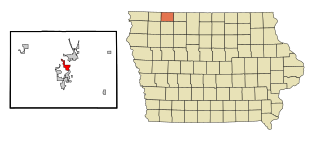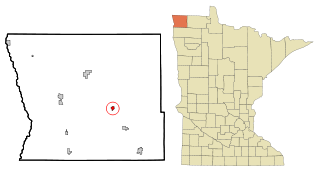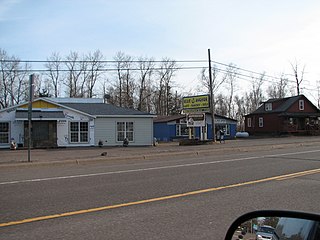
Florala is a town in Covington County, Alabama, United States. At the 2020 census, the population was 1,923.

Okoboji is a city in Dickinson County, Iowa, United States, along the eastern shore of West Okoboji Lake in the Iowa Great Lakes region. At the time of the 2020 census, its population was 768.

Orleans is a city in Dickinson County, Iowa, United States. The population was 521 at the time of the 2020 census. Orleans is part of the Iowa Great Lakes region, located along Spirit Lake. Numerous state parks are located within a few miles of the town, including Marble Beach and Mini-Wakan.

Superior is a city in Dickinson County, Iowa, United States. The population was 132 at the time of the 2020 census.

West Okoboji is a city in Dickinson County, Iowa, United States. The population was 308 at the time of the 2020 census. The city is located on West Okoboji Lake, from which it takes its name. It is part of the Iowa Great Lakes region.

Salix is a city in Woodbury County, Iowa, United States. It is part of the Sioux City, IA–NE–SD Metropolitan Statistical Area. The population was 295 at the time of the 2020 census.

Laingsburg is a city in Shiawassee County in the U.S. state of Michigan. The population was 1,283 at the 2010 census.

Sunburg is a city in Kandiyohi County, Minnesota, United States. The population was 100 at the 2010 census.

Lake Bronson is a city in Kittson County, Minnesota, United States. The population was 178 at the 2020 census. Lake Bronson State Park is nearby.

Beaver Bay is a city in Lake County, Minnesota, United States. The population was 120 at the 2020 census.

Silver Bay is a city in Lake County, Minnesota, United States. The population was 1,857 at the time of the 2020 census. It is the largest population center in a natural tourism area which includes, Tettegouche State Park and the Split Rock Lighthouse. It is a port along Lake Superior for iron ore and has taconite mining facilities of its own.

Le Roy is a city in Mower County, Minnesota, United States, surrounded by Le Roy Township. The population was 929 at the 2010 census. Lake Louise State Park is just outside the town.

Sturgeon Lake is a city in Pine County, Minnesota, United States. The population was 439 at the 2010 census.

Big Lake is a village in Holt County, Missouri, United States. The population was 65 at the 2020 census.

Crystal Lake Park is a Missouri Class 4 city in St. Louis County, Missouri, United States. The population was 508 at the 2020 census.

Spring Park is a small city nestled on the shores of Lake Minnetonka in Hennepin County, Minnesota, United States and is about 20 miles west of Minneapolis. The population was 1,669 at the 2010 census.

Battle Lake is a city in Otter Tail County, Minnesota, United States. The population was 857 according to the 2020 census.

Park River is a city in Walsh County, North Dakota, United States. The population was 1,424 at the 2020 census. Park River was founded in 1884.

Clear Lake is a city in and the county seat of Deuel County, South Dakota, United States. The population was 1,218 at the 2020 census.

Spring Lake Park is a city in Anoka and Ramsey counties in the state of Minnesota. The population was 6,412 at the 2010 census. The city is located mainly within Anoka County. Minnesota State Highways 47 and 65 and County Highway 10 are three of the main routes in the city.






















